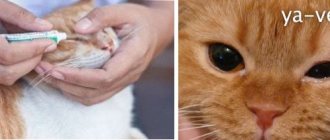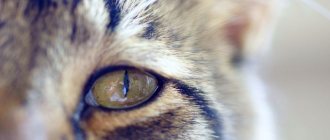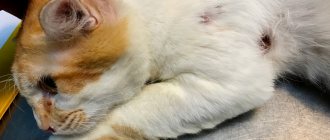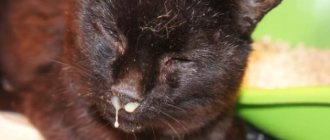Giving birth to a cat is an exciting process for the pet and its owners. The birth of one baby, contrary to the expected brood, raises concerns. Perhaps the cat did not give birth to all the kittens and surgery is necessary to remove the remaining cubs in the womb. But you should not panic if there is only one kitten in the mother's litter. In this case, all that is required from the owners is knowledge of the physiology of the pet and the ability to distinguish normality from pathology in time.
Can a cat only have one kitten?
As with other mammals, there are many factors that can affect pregnancy: age, physical health, sperm count, sperm motility and mating success are some examples. However, the number of kittens in a litter also depends on genetics. The results of fertilization are not easy to assess. Although it is rare, a female cat may only give birth to one kitten.
Another possible reason is that one or more kittens were also fertilized but did not develop properly. If the fetuses do not develop within a certain period of time, the mother cat will absorb them into her body. If they are not born but continue to develop, they will most likely be stillborn. Mother cats often eat their stillborn babies. If you did not witness the birth of the litter, the mother cat may have eaten the stillborn kitten, resulting in only one cat in the litter.
© shutterstock
Whatever the reason for having one kitten, don't worry, it doesn't in itself mean there's a health risk. Although this is not as common as in a multi-kitten litter, it is possible. You should know that pregnancy is a very delicate condition for any animal. It is very important that you set a minimum age before your cat can start breeding. Moreover, you should do your best to ensure her well-being, reassure her and always feed her well.
Signs of the end of labor
Not all and not always cat owners know what signs indicate the end of activity.
After forty minutes, the mother’s belly becomes soft.
- The first symptom is active care of the offspring. The animal diligently licks the kittens, purrs, and feeds.
- The pet breathes evenly, the pulse and heartbeat are stably rhythmic and do not go beyond physiological parameters.
- After a short time, the cat shows interest in food and drink. The pet can get up from the nest and leaves its brood for a while.
- After forty minutes, the mother’s abdomen becomes soft; palpation does not reveal any lumps.
- However, the uterus may remain in good shape for some time, which can be mistaken for a kitten.
- In this case, you should not squeeze the cat’s stomach too much; you should place both hands on the sides of the animal and carefully move along the ribs.
- It is recommended to check after the forty-minute period has expired.
- An additional sign is the cat’s calm behavior, but due to the fact that some mothers behave calmly even during childbirth, this sign is not a 100% guarantee.
Take your cat to the vet
Obviously, the best advisor is a veterinarian. They can rule out any signs of illness in your cat, run any tests if necessary, and give you some advice about feline pregnancy. However, if there are no symptoms and mother and kitten appear healthy, this is not necessary. In any case, if your cat has just given birth, you should closely monitor the health and well-being of the mother and kittens.
Although the cat may have other kittens that were consumed, it is possible that other kittens are otherwise healthy but fail to be born. Complications during a cat's birth may mean that the kittens are stuck or there are other difficulties during the birth. This is a serious situation that threatens the lives of both the future kittens and the mother cat. This will be considered a veterinary emergency and they should be taken to a veterinarian immediately.
You will be able to determine if there are any difficulties during the birth due to the behavior and symptoms of the mother cat. The time between the birth of each kitten is usually between 15 minutes and 1 hour. If your cat has not given birth to another kitten after an hour and is showing signs of distress, you will need to take her to the vet.
The mother may also experience what is called interrupted labor in cats. This is when the cat stops straining and begins to lick, nurse, and care for all the kittens that are born. Although this does not happen in most cases, it happens often enough to be considered relatively common. An interrupted labor can last up to 36 hours, although after this time it is unlikely that another kitten will be born. If a mother cat gives birth to one kitten and stops, but is fine after 24 hours or more, there is likely only one kitten in the litter.
© shutterstock
Birth of one kitten
It so happened that the first kitten was born, and there are no more offspring. You need to understand why this happened. What should you do in such a dual situation? Leave everything as is, or go to the veterinary clinic. If you look from a genetic point of view, this is possible. But this time there may be a difficult birth, and the pet is simply not able to give birth to the rest. And if you don’t catch it in time, the kittens will suffocate in the womb. Further known process, the fetus rots, resulting in blood poisoning and death.
You need to carefully monitor the cat the first day after birth and especially its behavior . If something hurts or bothers her, it is immediately noticeable. She may be hiding, or, on the contrary, she will not leave her owner’s side and meow, asking for help, or she may growl nervously.
Breeding Alternatives
You probably know that there are cat shelters in your city or country. If you're passionate about kittens or looking to expand your family, why not head to one of these places?
You should know that breeding a cat is neither easy nor practical. Although your cat may suffer from discomfort during pregnancy, millions of little kittens want to be cared for just like you.
Your cat is excited to give birth and bring new life into the world. You will see that there is a piece of fatherhood in the newborn kitten. However, there are many cats around the world who are stuck in shelters and have no home. By breeding your cat, you are unintentionally adding stress to this system and negatively impacting the welfare of all cats.
In addition, spaying your cat will benefit the cat itself by improving its health. We maintain a "don't buy" policy whenever possible.
Signs of unfinished labor
Before taking action, you need to check whether the cat can give birth to not all kittens at once. The situation can be found out by observing it. Signs that not all kittens have been born include the following:
- Mom lies on her side without changing position. There is little or no interest in children;
- the cat does not want to eat or drink;
- when observing an animal, you can periodically see how attempts occur;
- if you carefully palpate the tummy, you can feel a strong muscle tone;
- the mother has had a fever for a long time;
- Blood discharge is noticed from the uterus, during which an unpleasant odor can be felt.
Important! If there is an assumption that not all babies were born, it is necessary to call a specialist as soon as possible and send the cat to a veterinary clinic. In such cases, an ultrasound examination is performed to clarify the clinical picture and measures are taken according to the situation.
Bleeding may mean labor is not over
Giving birth to a cat at home
The cat's uterus is bicornuate. The horns, at the point of their connection, pass into the uterine canal, which passes through the cervix into the vagina, and it, through the vestibule of the vagina, into the vulva - this is the birth canal. The fetuses, protected by the amniotic membrane and fixed to the wall of the uterus by the placenta, are located in the horns of the uterus.
The first stage of labor can last from 12 to 24 hours. In the initial stage it may not be noticeable. It all starts with chaotic, voluntary contractions of the uterus (pushing), breathing quickens, the cat purrs to the beat. These contractions, in the form of peristaltic waves from the top of the uterine horn to its body, are at first rare and weak, the pain is of an unclear nature.
A few hours before contractions, the vagina swells slightly, and a thick sticky discharge appears from it, transparent, yellowish or bloody in color. The animal, at this time, is restless, licks the vulva (loop), strains, as if during defecation, meows pitifully, and rake up the bedding. The uterine horns contract alternately, pushing the fetuses into the uterus.
As the labor process progresses, contractions become more frequent, their duration increases, and the pain intensifies. When the uterus contracts (contractions), the fetus is pushed towards the cervix and it dilates. At the same time, the abdominal muscles contract and the fetus moves into the vagina. The cat at this time is completely at the mercy of childbirth. A first-time cat can be extremely frightened; she screams pitifully and seeks help from her owner. While watching her, constantly talk and pet her.
During contractions, intrauterine pressure increases and the vascular membrane (chorion) ruptures. The amnion (water membrane) and allantois (urinary membrane), filled with fluid, are embedded in the cervix, expanding its canal like a hydraulic wedge. With this
Source
Other interpretations
Among the variety of interpretations, the predictions of Nostradamus, Miller, and Vanga stand out for their originality.
Miller's Dream Book
The psychologist warns: if you see a dead kitten on the porch of your own house, then get ready for unexpected losses. Pay more attention to your loved ones, take your job responsibilities more seriously.
Vanga's Dream Book
The death of kittens in the house means the dreamer's internal struggle . His future fate depends on which path, spiritual or material, he chooses.
Modern dream book
If you saw dead kittens at the entrance to the house, your significant other will soon cross the threshold . And if one already exists, the dream foreshadows harmony in family life.
Dream Interpretation of Nostradamus
The great predictor interprets dead kittens in a dream as deceit, and it will be manifested by the one who dreamed about them.
Esoteric dream book
Seeing a dead cat near the house - get ready for a big family holiday, perhaps even a wedding.
why are kittens born dead
Dead kittens
The day before yesterday our cat gave birth to 3 kittens. All dead. Why? We took the cat to the veterinarian, she examined us and said that outwardly the cat was absolutely healthy. She recommended that we bring her back in a month to get tested for toxoplasmosis and chlamydia. But we have a square! It was installed on July 14 last year, the year has not yet passed. In addition, I recently donated blood for toxoplasmosis - I didn’t even have antibodies to it. Shortly before giving birth, the cat fell from the closet - could this have led to the death of ALL the kittens? The vet said it was very unlikely.
The pregnancy lasted 67 days. On the 65th day, the cat began to actively look for a place, demand attention to itself, and brown mucus came out of it in small quantities. Fell from the closet after 2 days. 5 hours after the fall, contractions began. After she gave birth to two kittens, the contractions stopped and resumed again only 12 hours later, then she gave birth to a third.
Domestic cat, 2 years old, first birth, kittens appear to be fully formed, about 10 cm in length (if the death of the kittens was caused by an infection, would the kittens die earlier or is this possible at the very end of pregnancy?). The cat is 6 years old, also vaccinated (the last time he was vaccinated was a few days before mating - could this have had an effect?), and has successfully bred other cats many times.
I am very afraid that next time the cat may give birth to dead kittens again - this is such stress for her. Now she meows all the time that she is not held in her arms and constantly checks the place where she gave birth, although before she was quite indifferent to him - apparently she is looking for kittens ((((
What causes dead kittens to be born, maybe the cat is to blame for having weak sperm??
Many different reasons. But the wording “weak sperm” does not fit. Maybe he has diseases that can be passed on genetically to his offspring. And so along the line itself to
Source
Pet health hazard
If fetal resorption occurs in a cat at an early stage of pregnancy, there is no need to worry about its health. As for spontaneous abortions, which occur in the later stages, they cause serious damage to the reproductive organs of the pet (rupture of the uterus or birth canal). Very often, large quantities of pus accumulate in the uterine cavity. In rare and most advanced cases, the cat develops intoxication of the body, which can lead to its death. That is why timely provision of assistance is very important.
One kitten in the litter
It is not uncommon for a cat to give birth to only one kitten. This may be due to the following reasons:
- the genetic predisposition of the cat itself (there are cases when, from generation to generation, cats of the same kind give birth to only 1-2 kittens);
- pregnancy of an animal at too young or too mature an age (more than 7 years);
- fertilization during mating of only 1 egg;
- problems with sperm quality in cats;
- the survival of only one fetus out of all;
- health problems in the cat, which also affected its fertile function.
However, you shouldn’t sit idly by and hope that this is exactly what happened. It is necessary to take all precautions and take a closer look at the behavior of the cat itself.
What to do if the fetus is in the birth canal
If the fetus remains in the birth canal, then this situation is dangerous for the animal. This means that it is dead and will sooner or later begin to decompose. One possible consequence of this is the loss of the ability to give birth to kittens.
Important! If the necessary help is not provided in time, this can lead to the death of the pet.
The use of special veterinary drugs can provoke additional labor pains and contribute to the birth of the baby. For this purpose, administration of oxytocin at a dose of 0.3 mg can be used. This should only be done as recommended by a veterinarian.
When using this type of product, it is necessary to take into account the possible allergic reaction of the animal.
If the last kitten cannot be born, the cat needs urgent help from the owner
Intrauterine death of kittens - causes and consequences
Most often, the reasons for the death of kittens before birth lie in intrauterine developmental disorders . Some embryos may die during multiple pregnancies. In this case, we can say that the body gets rid of excess load. In this case, the mother's body absorbs dead embryos. Congenital malformations that are incompatible with life may arise due to genetic defects or poor quality care for the mother in the early stages of pregnancy.
Quite often, intrauterine malformations are associated with chronic diseases of a pregnant cat . Constant stress, cold, physical damage, trauma and other external factors can lead to intrauterine death of kittens. It has been established that a deficiency of taurine in a cat's diet leads to a slowdown in the development of muscles and bones in fetuses. During cat pregnancy, it is not advisable to use any medications (especially toxic ones) without the prescription and supervision of a veterinarian.
There is reason to be wary
Some dream books negatively interpret what lifeless kittens may dream of. It is believed that these crumbs, accidentally strangled by the mother cat, warn the sleeping person about the dangers that threaten him. And if he himself killed a baby cat in a dream, then this is a signal - in real life you need to behave much more carefully and carefully, otherwise one wrong step will cause the collapse of all plans and dreams. Dream books also do not advise taking the initiative once again.
In general, a dead kitten in a dream represents potential troubles, the cause of which can be either sluggishness or excessive haste or fussiness.
And one more thing: take a closer look at the people around you; it is possible that among them there is an ill-wisher who is intentionally limiting your access to important information.
Signs and timing of pregnancy in cats
Cats carry kittens for about nine weeks, which equates to about 60 days. Some large breeds bear offspring longer, up to 63-65 days, while small ones - less, about 57. Each breed has its own optimal standard, since such animals do not reproduce uncontrollably, but only under the supervision of breeders, it is not difficult to count the period from conception from accurate to one day.
Expert opinion
Danilova Maria Alekseevna
Therapist, dentist, ophthalmologist, surgeon, express tests, ratologist, groomer.
A cat is ready to become a mother for the first time at the age of 5 to 9 months, but this period may shift. There are many factors that influence an animal's reproductive process. Body size, breed, general health and even the length of daylight hours all matter in one way or another. As a result, the age of a cat for the first pregnancy can vary from 3.5 (that is, pregnancy occurs even in small kittens) to 18 months.
The mating process is carried out on the male’s territory, because otherwise, the “bride” will be too aggressive towards her “groom”, as a result of which the cat can sit behind a closet, behind a sofa and in another “inaccessible” place for up to several days. The first signs of pregnancy in cats appear after about two weeks, and then increase in severity. Among them are the following:
- The cat becomes inactive, jumps and runs less. The change is especially noticeable in initially active animals.
- Appetite increases, because you need to feed future offspring.
- In the early stages of pregnancy, toxicosis is possible, as in humans, expressed in the form of regurgitation after eating.
- The appearance changes after 21-23 days. The mammary glands swell and the sides become rounded.
Gradually, pregnancy becomes visible to the naked eye. The cat will take care of its belly, although if it loves and trusts its owner very much, then on the contrary, it can invite you to pet it and relieve it of discomfort.
A pregnant cat does not require special care, except that she will need more food and will visit the litter box more often. But it is advisable to entrust the birth to an experienced veterinarian, especially if this happens for the first time. Signs of impending labor:
- anxiety;
- refusal to eat;
- a cat licking itself is a sign that its water is breaking;
- rapid breathing.
It is not advisable to take the animal to the clinic; cats prefer to give birth in their own home , in safety, in a cozy “nest”, where the kittens will then be raised in the first days of life. It is ideal to invite a doctor to your home, but this is important only for first-time cats; older animals are quite capable of coping on their own. The young should be monitored so that the cat, eating the amniotic sac, does not accidentally strangle the small kitten.
Expect positive changes
If you dreamed that a dead kitten came to life, be prepared for good results from your labors. The black stripe will abruptly change to white if you happen to dream that a small representative of the cat family has risen before your eyes and begun to purr. This gentle creature, according to Vanga’s dream book, will bring changes in family and personal life.
The healer interprets even more interestingly why a woman dreams of a dead kitten. The dream means that the annoying boyfriend will finally leave behind and make room for more worthy admirers.
Veterinarians' Answers to Common Questions
For cat owners who have not yet experienced the birth of an animal, the birth of kittens from a pet is a serious cause for concern.
After all, they do not know about the peculiarities of the course of childbirth and preparation for a responsible process. Veterinarians provide advice and answer common questions from new breeders.
How to prepare for the birth of a cat?
In order for your pet to give birth normally, it is important to provide the animal with optimal living conditions and adequate nutrition during pregnancy.
10-14 days before giving birth, you need to prepare a nest for the pet where the animal will give birth. Usually this is a box or a spacious basket, where the cat will feel comfortable and safe. The bottom is lined with several layers of flannel or fleece fabric, which you don’t mind throwing away later. You need to accustom your cat to the place in advance, otherwise she will choose a secluded corner for herself.











